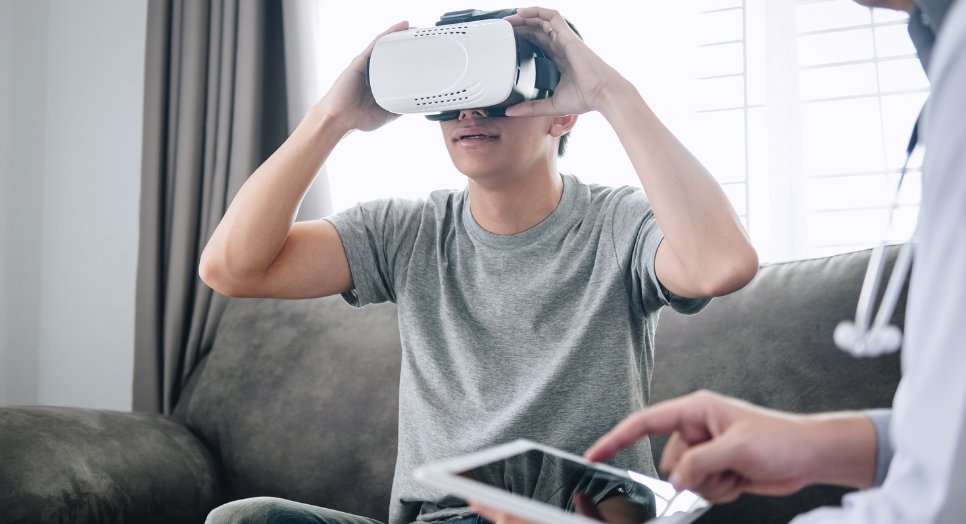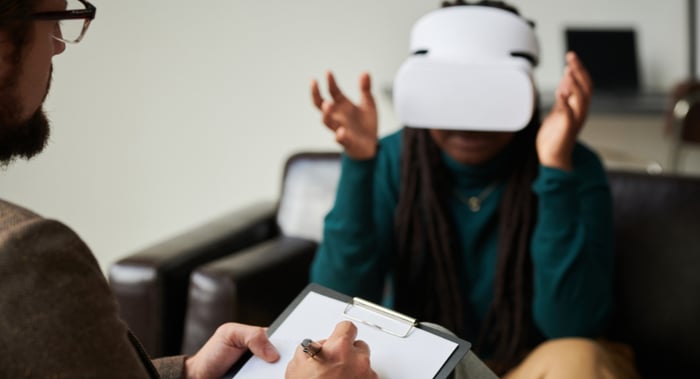Virtual Reality in Healthcare: Bridging the Gap Between Patients and Therapists

Imagine Chris Hemsworth, the action-packed star we know as Thor, Norse god of thunder, standing on a ledge overlooking Sydney Harbor, 900 ft above the ground. You’d think a superhero wouldn’t flinch at heights, right? Well, not quite.
Hemsworth, like many of us, has a fear of heights. But what if you could put on a headset and conquer your fears, just like he did? Believe it or not, Hemsworth used Virtual Reality (VR) as a form of exposure therapy to face and manage this stress, enabling him to walk out onto the arm of a crane projecting from the roof of a Sydney skyscraper.
And here's the incredible part - this type of therapy isn't limited to celebrities or superheroes.
Virtual reality in healthcare is redefining everything from surgical training to pain management. When combined with the emotional and cognitive benefits of music, healthcare providers can offer richer, more effective, and more personalized therapeutic experiences.
Read on as we delve into this fascinating intersection of virtual reality technology and health.
How is VR used in healthcare?
Virtual Reality (VR) has been breaking barriers across various industries, and healthcare is no exception. From training surgeons to managing chronic pain, VR's applications in healthcare are as diverse as they are revolutionary. Here are some of the ways VR is used in healthcare today:
VR for exposure therapy
The Phobia Solution
I may not be afraid of heights, but the thought of an eight-legged intruder spinning its web is enough to send shivers down my spine. Luckily, phobias and fears don't always need years of traditional therapy for effective treatment.
With VR, patients can immerse themselves in environments that stimulate their fears under the watchful eye of their therapist. Adding calming music can reduce anxiety, acting as an emotional cushion when facing fears. The controlled exposure helps individuals gradually become desensitized to their triggers, potentially resolving long-standing phobias in a fraction of the time it would take through conventional methods.
From PTSD to peace
For those grappling with Post-Traumatic Stress Disorder (PTSD), VR offers a unique form of therapy that helps them confront and process traumatic memories in a safe space. Customized scenarios allow patients to revisit traumatic events under controlled conditions. And adding thoughtfully curated VR music can make the virtual experiences even more impactful, making it easier for them to cope and heal.
Tackling social anxiety
Social anxiety can be debilitating, preventing people from fully participating in life's varied experiences. VR environments can simulate social scenarios through familiar visuals and soundscapes—be it a crowded mall, a busy workplace, or a family gathering—offering a sandbox for practicing social interactions without the fear of real-world consequences. This practice can give patients the confidence to engage in social situations outside of therapy.
VR for mental health
Anxiety is one of the most common mental health conditions in the United States. Generalized Anxiety Disorder (GAD) affects 6.8 million adults, while 15 million adults have been diagnosed with Social Anxiety Disorder.
A study published in Cell revealed that VR therapy reduced stress and anxiety in patients by 34%. XRHealth uses VR technology for therapeutic intervention, decreasing stress in 73% of patients.

Where movement meets virtual worlds: VR for physical therapy
In addition to providing entertainment, VR fitness games offer an affordable solution to enhance recovery and overall wellness after surgery. As highlighted by Athletech News, VR gamification is emerging as a powerful tool to keep patients engaged and focused during their rehabilitation journeys.
With VR, patients find themselves in interactive worlds where physical therapy exercises turn into engaging activities and games. The right music prepares a patient for movement, distracts them from fatigue, provides a metronomic-type function during exercise, and then returns the exerciser to a calm and revitalized state after their session. The activities are tailored to the individual’s specific recovery needs and can progress in difficulty as the patient improves, providing a customized and dynamic approach to physical therapy.
Altering the brain’s perception of pain: VR for pain management
AppliedVR, a pioneer advancing the next generation of immersive therapeutics, is solving pain through virtual reality-based treatments. By adding engaging visuals, sounds, and even sensations, a sensory-rich environment is created that makes people feel as if they truly are in a different world.
This enables patients suffering from pain to follow a science-backed, clinically validated curriculum of immersive VR programming to reduce their pain and help them learn skills for managing pain in the real world.
Step inside the operating room: VR for medical training
Remember how medical students once had to crowd around a surgery table to get a glimpse of a procedure? Not anymore. Through VR simulation, medical students and professionals can practice surgeries and procedures in a risk-free environment. A study published by the Harvard Business Review discusses how VR training significantly improves surgical performance by 230%.
What is the future of VR in healthcare?
While VR may not be a replacement for in-person therapeutics, it has the potential to build a digital bridge that strengthens the connection between patients and therapists.
Many hospitals already utilize VR to alleviate pain following surgery, during labor, or during cancer treatment. However, it’s too early to determine if VR will become a standard component of chronic pain management.
According to Dr. Binder, a physiatrist and director of innovation at Spaulding Rehabilitation Hospital, "If VR content shows clear improvement, lower pain scores, and faster recovery, and if there’s evidence from respected academic centers, the big technology companies would likely be interested. They’re already investing heavily in VR… and you might see VR being adopted at a level never imagined."
Functional music for VR/AR applications
Functional music integration plays a pivotal role in VR healthcare applications. It’s more than just an aesthetic choice—it's a strategic one that taps into our fundamental emotional and physiological responses.
Several studies have demonstrated the power of music as medicine—music’s ability to distract the mind and release endorphins—which adds another dimension to the already effective VR applications in therapy and pain management.
Feed.fm is on a mission to connect businesses and individuals with the healing power of music. Our recognizable major-label and science-backed wellness music collections integrate seamlessly into your VR/AR experience with our quick-to-integrate SDKs.
Talk to one of our music specialists to learn more about functional music for your VR/AR health application.


 2 min
2 min